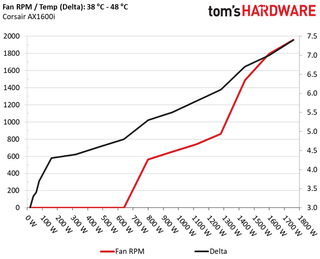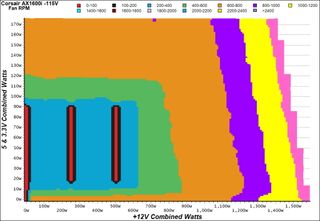Corsair AX1600i PSU Review
Why you can trust Tom's Hardware
Efficiency, Temperature & Noise
Efficiency
Our efficiency testing procedure is detailed here.
Using results from the previous page, we plotted a chart showing the AX1600i's efficiency at low loads, and loads from 10 to 110 percent of its maximum-rated capacity.




This PSU's efficiency is out-of-this-world, especially under light loads.
Efficiency At Low Loads
In the following tests, we measure the AX1600i's efficiency at loads significantly lower than 10 percent of its maximum capacity (the lowest load the 80 PLUS standard measures). The loads we dialed were 20, 40, 60, and 80W. This is important for representing when a PC is idle, with power-saving features turned on.
| Test # | 12V | 5V | 3.3V | 5VSB | DC/AC (Watts) | Efficiency | Fan Speed | PSU Noise | PF/AC Volts |
|---|---|---|---|---|---|---|---|---|---|
| 1 | 1.212A | 0.502A | 0.482A | 0.201A | 19.679 | 65.803% | 0 RPM | <6.0 dB(A) | 0.887 |
| 12.027V | 4.991V | 3.305V | 4.988V | 29.906 | 115.10V | ||||
| 2 | 2.455A | 0.999A | 0.995A | 0.401A | 39.802 | 80.976% | 0 RPM | <6.0 dB(A) | 0.944 |
| 12.027V | 4.991V | 3.307V | 4.986V | 49.153 | 115.10V | ||||
| 3 | 3.696A | 1.497A | 1.508A | 4.985A | 59.910 | 85.527% | 0 RPM | <6.0 dB(A) | 0.920 |
| 12.027V | 4.993V | 3.307V | 4.985V | 70.048 | 115.10V | ||||
| 4 | 4.926A | 2.005A | 1.995A | 0.801A | 79.843 | 87.882% | 0 RPM | <6.0 dB(A) | 0.917 |
| 12.026V | 4.994V | 3.307V | 4.983V | 90.853 | 115.10V |
With only 20W load (1.25% of this unit's capacity), the efficiency we measure is quite high at almost 66%. During the other three tests, our efficiency results improve significantly, easily surpassing the 80% mark. We would like to see higher PF readings, though, given that the PFC converter is digitally controlled. It probably needs some fine-tuning under light loads.
Corsair Link Screenshots
Below you will find screenshots of the Corsair Link software, which we took during the light-load test sessions.




5VSB Efficiency
The ATX specification, along with CEC, ErP Lot 3 2014 and ErP Lot 6 2010/2013, states that 5VSB standby supply efficiency should be as high as possible, recommending 75 percent or higher with 550mA, 1A, and 1.5A of load. The PSU should also achieve higher than 75% efficiency at 5VSB under full load, or with 3A if its max current output on this rail is higher than 3A.
We take six measurements: one each at 100, 250, 550, 1000, and 1500mA, and one with the full load the 5VSB rail can handle.
| Test # | 5VSB | DC/AC (Watts) | Efficiency | PF/AC Volts |
|---|---|---|---|---|
| 1 | 0.101A | 0.511 | 77.778% | 0.039 |
| 5.038V | 0.657 | 115.14V | ||
| 2 | 0.252A | 1.268 | 81.074% | 0.092 |
| 5.035V | 1.564 | 115.12V | ||
| 3 | 0.542A | 2.729 | 80.123% | 0.185 |
| 5.032V | 3.406 | 115.16V | ||
| 4 | 1.002A | 5.036 | 83.075% | 0.290 |
| 5.025V | 6.062 | 115.11V | ||
| 5 | 1.502A | 7.535 | 83.444% | 0.371 |
| 5.018V | 9.030 | 115.14V | ||
| 6 | 3.502A | 17.476 | 81.897% | 0.516 |
| 4.991V | 21.339 | 115.16V |


The 5VSB rail is very efficient as well. Flextronics obviously put some effort into this circuit's design.
Power Consumption In Idle And Standby
In the table below, you'll find the power consumption and voltage values of all rails (except -12V) when the PSU is idle (powered on, but without any load on its rails), and the power consumption when the PSU is in standby mode (without any load, at 5VSB).
| Mode | 12V | 5V | 3.3V | 5VSB | Watts | PF/AC Volts |
|---|---|---|---|---|---|---|
| Idle | 12.027V | 5.011V | 3.305V | 5.009V | 9.472 | 0.536 |
| 115.1V | ||||||
| Standby | 0.048 | 0.003 | ||||
| 115.1V |


The power consumption at idle is kept super low with both 115V and 230V input.
Fan RPM, Delta Temperature, And Output Noise
Our mixed noise testing is described in detail here.
The first chart below illustrates the cooling fan's speed (in RPM), and the delta between input and output temperature. The results were obtained at 38°C (100.4°F) to 48°C (118.4°F) ambient temperature.

The next chart shows the cooling fan's speed (again, in RPM) and output noise. We measured acoustics from one meter away, inside a hemi-anechoic chamber. Background noise inside the chamber was below 6 dB(A) during testing (it's actually much lower, but our sound meter’s microphone hits its floor), and the results were obtained with the PSU operating at 38°C (100.4°F) to 48°C (118.4°F) ambient temperature.

The following graph illustrates the fan's output noise over the PSU's operating range. The same conditions of the above graph apply to our measurements, though the ambient temperature was between at 30°C (86°F) to 32°C (89.6°F).

The fan profile is highly relaxed, especially if we take into account that this is a 1.6kW PSU.
The last graph illustrates the fan's speed over the PSU's operating range. The same conditions with the previous graph apply to our measurements, including the ambient temperature.

Once you push the minor rails hard, the semi-passive mode doesn't last long, however the fan's speed is kept low.
MORE: Best Power Supplies
MORE: How We Test Power Supplies
MORE: All Power Supply Content
Current page: Efficiency, Temperature & Noise
Prev Page Load Regulation, Hold-Up Time & Inrush Current Next Page Protection FeaturesStay on the Cutting Edge
Join the experts who read Tom's Hardware for the inside track on enthusiast PC tech news — and have for over 25 years. We'll send breaking news and in-depth reviews of CPUs, GPUs, AI, maker hardware and more straight to your inbox.
Aris Mpitziopoulos is a Contributing Editor at Tom's Hardware US, covering PSUs.
-
Quaddro all of we need is 500w class digital titanium++ psu with this advance technology..Reply
Well, pc is much more efficient right now..
I wonder how many people will use it anyway... -
Aris_Mp Videos working fine here.Reply
PCs are more efficient, however graphics cards once pushed are not and many users tend to overclock their GPUs. Moreover, those units are intended for multi-GPU systems. -
SoerenHedemand Do you do you fan and noise measurements with 110V or 220V? That should make a difference in this case at least.Reply -
Aris_Mp Reply20574970 said:Do you do you fan and noise measurements with 110V or 220V? That should make a difference in this case at least.
115V but I also take noise measurements with 230V because of Cybenetics.
115V: 23.25 dB(A)
230V: 23.29 dB(A)
-
SoerenHedemand Specifically at what point does it change from passive to active cooling using either 110V or 220V?Reply -
ptlin.ece90g Primary DSC should be NXP Freescale MC56F8236Reply
Secondary DSC is Texas Instruments UCD3138064A